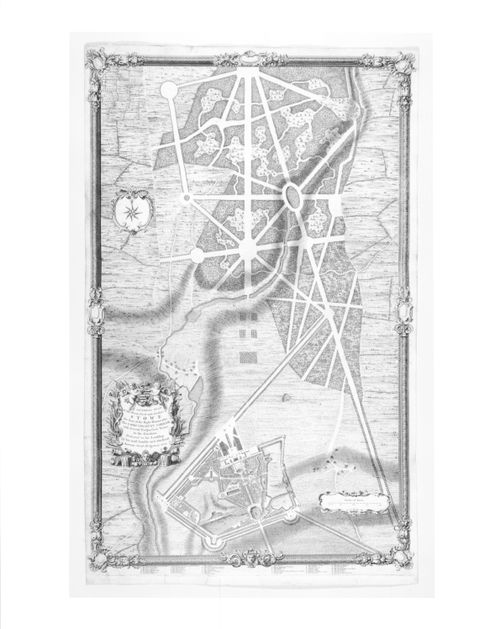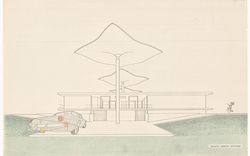General plan of Stowe
DR1982:0096:001
Description:
- A plan (with legend) of Stowe gardens (defined by an irregular pentagon at the bottom of the print), together with the layout of the forest garden stretching north beyond the garden boundry and containing long intersecting rides cut through the woodlands. An elaborate cartouche (lower left), formed of military paraphernalia, encloses a dedication to Viscount Cobham, owner of the property. - The marbled and leather-edged portfolio in which the prints were acquired is stored separately in a solander box (size IV).
architecture, architecture de paysage
designed ca. 1738
General plan of Stowe
Actions:
DR1982:0096:001
Description:
- A plan (with legend) of Stowe gardens (defined by an irregular pentagon at the bottom of the print), together with the layout of the forest garden stretching north beyond the garden boundry and containing long intersecting rides cut through the woodlands. An elaborate cartouche (lower left), formed of military paraphernalia, encloses a dedication to Viscount Cobham, owner of the property. - The marbled and leather-edged portfolio in which the prints were acquired is stored separately in a solander box (size IV).
architecture, architecture de paysage
Projet
AP022.S1.1969.PR08
Description:
File documents a central core complex of multiple towers on a city block (not built) , Winnipeg, Manitoba. File contains design development drawings and rextual records.
1969-1971
Winnipeg Project
Actions:
AP022.S1.1969.PR08
Description:
File documents a central core complex of multiple towers on a city block (not built) , Winnipeg, Manitoba. File contains design development drawings and rextual records.
Project
1969-1971
Projet
AP018.S1.1980.PR05
Description:
This project series documents alterations and additions to the home of Conrad and Shirley Black in North York, Ontario from 1980-1982. The office identified the project number as 8007. This project consisted of extensive alterations to the interior of the four-floor Black residence, as well as additions on all sides of the exterior facade. This project also included landscaping to the surrounding property. The extended exterior was finished in brick. Alterations and upgrades were made to almost every room in the house. The project is recorded through drawings, photographic materials and textual records dating from 1980-1984. The majority of original drawings show elevations and brick coursing plans for the new exterior. Photographic materials show the exterior of the residence before the project, as well as construction progress photos during the project. The textual records include correspondence, contract data, site and meeting reports, tender documents, design consultancy records, financial records, supplementary instructions, change orders, specifications and project notebooks. Box AP018.S1.1980.PR07.008 contains an index to the textual materials, which was created by the office.
1980-1984
Residence of Mr. and Mrs. C. M. Black, Alterations and Additions, North York, Ontario (1980-1982)
Actions:
AP018.S1.1980.PR05
Description:
This project series documents alterations and additions to the home of Conrad and Shirley Black in North York, Ontario from 1980-1982. The office identified the project number as 8007. This project consisted of extensive alterations to the interior of the four-floor Black residence, as well as additions on all sides of the exterior facade. This project also included landscaping to the surrounding property. The extended exterior was finished in brick. Alterations and upgrades were made to almost every room in the house. The project is recorded through drawings, photographic materials and textual records dating from 1980-1984. The majority of original drawings show elevations and brick coursing plans for the new exterior. Photographic materials show the exterior of the residence before the project, as well as construction progress photos during the project. The textual records include correspondence, contract data, site and meeting reports, tender documents, design consultancy records, financial records, supplementary instructions, change orders, specifications and project notebooks. Box AP018.S1.1980.PR07.008 contains an index to the textual materials, which was created by the office.
Project
1980-1984
Projet
AP056.S1.1997.PR09
Description:
This project series documents the Sheff Residence at 105 Glen Road in Toronto from 1997-2001. The office identified the project number as 9727. This project consisted of a large home for architect Gerald Sheff and his wife Shanitha Kachan. The work included the demolition of a single-storey dwelling already on the property to create a roughly 7,900 square foot, mixed-level home. This project investigated multiple schemes for the residence, which looked at different room configurations and placements, different building heights, and different levels of finish for certain rooms. Built overlooking a ravine, the house had a stone veneer exterior with accents of wood siding and large glass windows. The home had a maximum height of two-storeys with a basement and included a swimming pool and backyard deck. This residence won the Ontario Association of Architect's Award of Excellence in 2003. The project is recorded through a model and drawings dating from 1996-2000. The majority of the drawings are sketches, but plans, elevations, sections, perspectives and details are included. There are also many drawings of furnishings including closets, benches and custom furniture.
1996-2000
Sheff Residence, Toronto (1997-2001)
Actions:
AP056.S1.1997.PR09
Description:
This project series documents the Sheff Residence at 105 Glen Road in Toronto from 1997-2001. The office identified the project number as 9727. This project consisted of a large home for architect Gerald Sheff and his wife Shanitha Kachan. The work included the demolition of a single-storey dwelling already on the property to create a roughly 7,900 square foot, mixed-level home. This project investigated multiple schemes for the residence, which looked at different room configurations and placements, different building heights, and different levels of finish for certain rooms. Built overlooking a ravine, the house had a stone veneer exterior with accents of wood siding and large glass windows. The home had a maximum height of two-storeys with a basement and included a swimming pool and backyard deck. This residence won the Ontario Association of Architect's Award of Excellence in 2003. The project is recorded through a model and drawings dating from 1996-2000. The majority of the drawings are sketches, but plans, elevations, sections, perspectives and details are included. There are also many drawings of furnishings including closets, benches and custom furniture.
Project
1996-2000
Projet
AP022.S1.1988.PR03
Description:
File documents a phased office complex of six buildings, Brimley Road, Scarborough, Ontario. File contains design development drawings (including photographs).
1988-1989
Transmetro Office Building Development
Actions:
AP022.S1.1988.PR03
Description:
File documents a phased office complex of six buildings, Brimley Road, Scarborough, Ontario. File contains design development drawings (including photographs).
Project
1988-1989
Projet
AP056.S1.1992.PR02
Description:
This project series documents the federal women's prison in Kitchener, Ontario, now called The Grand Valley Institution for Women, from 1992-1994. The office identified the project number as 9227. This project, built for Public Works Canada and Correctional Services Canada, consisted of a large, main prison building with nine small cottages lining the property. The main building included the admission and discharge area, food services, recreation spaces and spirituality centre, as well as an area for prisoners requiring enhanced security. The spirituality room was a window-rimmed rotunda that pierced the slanted roof of the main stucco building. The smaller cottages were wood-sided with aluminum windows and could house eight people. While many were built to house eight prisoners, some designs replaced prisoner's rooms with children's bedrooms for inmates who had children staying with them. There was also a large, green space in the centre of all the buildings, with plans to build a baseball diamond, daycare building and an additional cottage in the future. The project is recorded through drawings dating from1992-1995. The drawings and mostly originals and include site surveys, sketches, plans, elevations, sections, perspectives, details and axonometric drawings.
1992-1995
Regional Facility for Federally Sentenced Women, Kitchener, Ontario (1992-1994)
Actions:
AP056.S1.1992.PR02
Description:
This project series documents the federal women's prison in Kitchener, Ontario, now called The Grand Valley Institution for Women, from 1992-1994. The office identified the project number as 9227. This project, built for Public Works Canada and Correctional Services Canada, consisted of a large, main prison building with nine small cottages lining the property. The main building included the admission and discharge area, food services, recreation spaces and spirituality centre, as well as an area for prisoners requiring enhanced security. The spirituality room was a window-rimmed rotunda that pierced the slanted roof of the main stucco building. The smaller cottages were wood-sided with aluminum windows and could house eight people. While many were built to house eight prisoners, some designs replaced prisoner's rooms with children's bedrooms for inmates who had children staying with them. There was also a large, green space in the centre of all the buildings, with plans to build a baseball diamond, daycare building and an additional cottage in the future. The project is recorded through drawings dating from1992-1995. The drawings and mostly originals and include site surveys, sketches, plans, elevations, sections, perspectives, details and axonometric drawings.
Project
1992-1995
articles
Un parapluie peut aussi être une maison
Une sélection de dessins de la Casa Desmarás conçue par Amancio Williams
Actions:
Projet
Entre deux rues, Montréal
AP027.S1.D59
Description:
Proposed commercial infill concept for the development of the city block bounded by Sherbrooke St., de la Montagne St., de Maisonneuve Ouest Blvd., and Crescent St. in Montréal. The design was specific to the site, but developed to apply to any area where there was economic pressure to intensify land use and where the buildings warranted preservation. The plan featured a multi-level galleria over the lane and an extension of the rear of existing properties to connect with it.
urbanisme
1971-1972
Entre deux rues, Montréal
Actions:
AP027.S1.D59
Description:
Proposed commercial infill concept for the development of the city block bounded by Sherbrooke St., de la Montagne St., de Maisonneuve Ouest Blvd., and Crescent St. in Montréal. The design was specific to the site, but developed to apply to any area where there was economic pressure to intensify land use and where the buildings warranted preservation. The plan featured a multi-level galleria over the lane and an extension of the rear of existing properties to connect with it.
File 59
1971-1972
urbanisme
Série(s)
AP179.S1
Description:
Series 1, Casa La Roca, Caracas, Venezuela, 1995 – 2001, documents the development of a project (unrealized) for a residential home situated among the hills at the southern edge of Caracas. The majority of records were produced between 1995 and 1997. The series consists of sketches, drawings and reprographic copies for the conceptual and design development phases of the project, a wood model and model pieces, photographs of the site, and textual records including correspondence and zoning records. The series also contains an oversized banner printed with an image of the model that was featured in the Fabrications exhibition at the Museum of Modern Art, New York, in 1998, as well as plans for the show. The digital material in this series consists of an animated rendering of the brick patio wall and photographs of the physical drawings and the model for Casa La Roca. The name of the project, Casa la Roca (in English, “the rock house”), is derived from a large mass of rock that occupies the back of the property. The design utilizes the presence of the rock, in combination with sliding glass doors and windows, to create an “outdoor room” that functions both as a living space and back yard. The design also incorporates the nature of the site through the use of materials such as terracotta block, brick, and tile.
1995 - 2001
Casa La Roca, Caracas, Venezuela (1995 - 2001)
Actions:
AP179.S1
Description:
Series 1, Casa La Roca, Caracas, Venezuela, 1995 – 2001, documents the development of a project (unrealized) for a residential home situated among the hills at the southern edge of Caracas. The majority of records were produced between 1995 and 1997. The series consists of sketches, drawings and reprographic copies for the conceptual and design development phases of the project, a wood model and model pieces, photographs of the site, and textual records including correspondence and zoning records. The series also contains an oversized banner printed with an image of the model that was featured in the Fabrications exhibition at the Museum of Modern Art, New York, in 1998, as well as plans for the show. The digital material in this series consists of an animated rendering of the brick patio wall and photographs of the physical drawings and the model for Casa La Roca. The name of the project, Casa la Roca (in English, “the rock house”), is derived from a large mass of rock that occupies the back of the property. The design utilizes the presence of the rock, in combination with sliding glass doors and windows, to create an “outdoor room” that functions both as a living space and back yard. The design also incorporates the nature of the site through the use of materials such as terracotta block, brick, and tile.
Series
1995 - 2001
*Montréal, ville fortifiée du XVIIIe siècle* explore l’évolution de la ville au XVIIIe siècle, alors qu’elle était une ville fortifiée. Cet événement offre une occasion unique de se renseigner sur l’essor de la ville commerciale et militaire à l’origine de la métropole actuelle. Couronnant presque quinze années de recherche et la création d’une(...)
Salles principales
8 septembre 1992 au 28 février 1993
Montréal, ville fortifiée au XVIIIe siècle
Actions:
Description:
*Montréal, ville fortifiée du XVIIIe siècle* explore l’évolution de la ville au XVIIIe siècle, alors qu’elle était une ville fortifiée. Cet événement offre une occasion unique de se renseigner sur l’essor de la ville commerciale et militaire à l’origine de la métropole actuelle. Couronnant presque quinze années de recherche et la création d’une(...)
Salles principales


